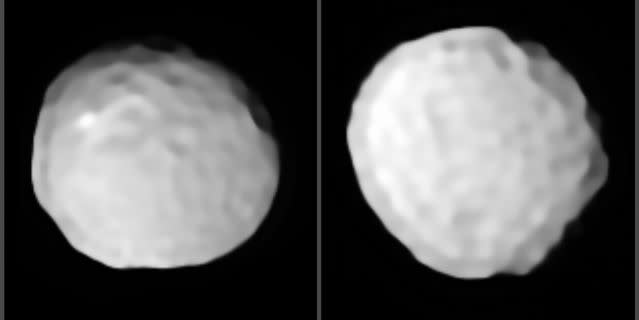Hey, Doesn't This Asteroid Look Like a Giant Golf Ball?

Astronomers have taken stunning new images of a golf ball-shaped asteroid called Pallas zipping through the asteroid belt.
The mottled celestial body has the most cratered surface in the solar system, thanks to its tilted orbit.
Pallas also has a cosmic connection to the Geminids meteor shower.
Astronomers have sunk a celestial hole-in-one.
An international research team has discovered a pock-marked asteroid that it's dubbed the "golf ball" asteroid. Pallas, as it's officially called, is currently zipping along its orbit in the asteroid belt.
Named for the Greek goddess of wisdom, the hefty Pallas is the third largest object in the asteroid belt, next to Ceres and Vesta. Astronomers believe it has a violent, checkered past, which they're just beginning to unravel.
The team used the European Southern Observatory’s Very Large Telescope—an array of four telescopes, each of which have a 26-foot-wide mirrors—nestled in Chile's Atacama desert to get updated images of the asteroid. Over the course of two observation periods in 2017 and 2019, astronomers collected 11 images, which they stitched together to form a 3D image of the celestial object and a map of its crater-speckled surface.
The results were fascinating. A paper published last week in the journal Nature Astronomy reveals that Pallas, which scientists discovered in 1802, may have a mottled surface because of its curious orbit.
While most asteroids in the asteroid belt orbit along a similar elliptical plane, Pallas' orbit is tilted, meaning the celestial body often collides with other objects in the belt. “Pallas’ orbit implies very high-velocity impacts,” astronomer Michaël Marsset of MIT said in a
press statement. “From these images, we can now say that Pallas is the most cratered object that we know of in the asteroid belt. It’s like discovering a new world.”
One particularly large collision, which formed a nearly 250-mile-wide crater along the asteroid's equator, occurred roughly 1.7 million years ago, the team announced. Debris from the impact now trails the asteroid as it slides along its orbit, according to the statement.
The scientists also discovered a large, bright splotch on Pallas' surface, which they believe may be evidence of a large salt deposit. Curiously, the best evidence for this may lie in phenomenon that swings much closer to Earth: the Geminids. The famed meteor shower that graces chilly night skies in December occurs because Earth passes through the dusty, salt-rich trail of the asteroid Phaethon, which astronomers believe to be a chunk of Pallas that was cleaved off millions of years ago.
How's that for a cosmic connection?
You Might Also Like

 Yahoo News
Yahoo News 